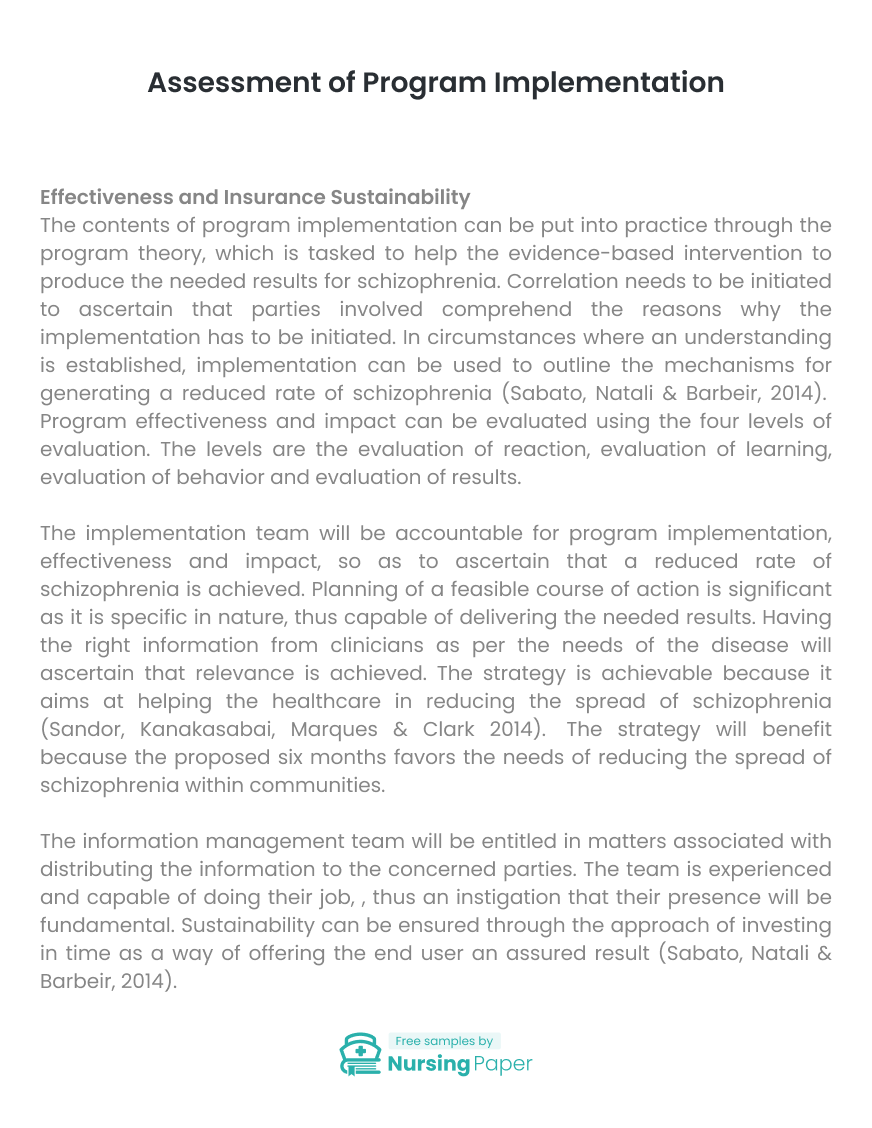
Assessment of Program Implementation
Effectiveness and Insurance Sustainability
The contents of program implementation can be put into practice through the program theory, which is tasked to help the evidence-based intervention to produce the needed results for schizophrenia. Correlation needs to be initiated to ascertain that parties involved comprehend the reasons why the implementation has to be initiated. In circumstances where an understanding is established, implementation can be used to outline the mechanisms for generating a reduced rate of schizophrenia (Sabato, Natali & Barbeir, 2014). Program effectiveness and impact can be evaluated using the four levels of evaluation. The levels are the evaluation of reaction, evaluation of learning, evaluation of behavior and evaluation of results.
The implementation team will be accountable for program implementation, effectiveness and impact, so as to ascertain that a reduced rate of schizophrenia is achieved. Planning of a feasible course of action is significant as it is specific in nature, thus capable of delivering the needed results. Having the right information from clinicians as per the needs of the disease will ascertain that relevance is achieved. The strategy is achievable because it aims at helping the healthcare in reducing the spread of schizophrenia (Sandor, Kanakasabai, Marques & Clark 2014). The strategy will benefit because the proposed six months favors the needs of reducing the spread of schizophrenia within communities.


The information management team will be entitled in matters associated with distributing the information to the concerned parties. The team is experienced and capable of doing their job, , thus an instigation that their presence will be fundamental. Sustainability can be ensured through the approach of investing in time as a way of offering the end user an assured result (Sabato, Natali & Barbeir, 2014). The move ensures that benefits to the targeted community or group are achieved in the right measures.
1. Sabato, S., Natali, S., & Barbeir, C. (2014). A Model for Implementing Sustainable and Qualitative Growth, Wilfried Martens Center for European Studies.
2. Sandor, R., Kanakasabai, M., Marques, R., & Clark N. (2014). Sustainable Investing and Environmental Markets: Opportunities in a New Asset Class, World Scientific.



The download will start shortly.

The download will start shortly.
 Subject:
Health and Social Care
Subject:
Health and Social Care  Number of pages: 4
Number of pages: 4  Subject:
Medicine
Subject:
Medicine  Number of pages: 13
Number of pages: 13  Subject:
Medicine
Subject:
Medicine  Number of pages: 4
Number of pages: 4  Subject:
Health and Social Care
Subject:
Health and Social Care  Number of pages: 2
Number of pages: 2  Subject:
Health and Social Care
Subject:
Health and Social Care  Number of pages: 4
Number of pages: 4  Subject:
Health and Social Care
Subject:
Health and Social Care  Number of pages: 3
Number of pages: 3  Subject:
Medicine
Subject:
Medicine  Number of pages: 3
Number of pages: 3  Subject:
Medicine
Subject:
Medicine  Number of pages: 5
Number of pages: 5  Subject:
Medicine
Subject:
Medicine  Number of pages: 4
Number of pages: 4  Subject:
Medicine
Subject:
Medicine  Number of pages: 6
Number of pages: 6  Subject:
Medicine
Subject:
Medicine  Number of pages: 3
Number of pages: 3  Subject:
Medicine
Subject:
Medicine  Number of pages: 2
Number of pages: 2  Subject:
Nursing
Subject:
Nursing  Number of pages: 5
Number of pages: 5  Subject:
Health and Social Care
Subject:
Health and Social Care  Number of pages: 5
Number of pages: 5  Subject:
Medicine
Subject:
Medicine  Number of pages: 3
Number of pages: 3 
